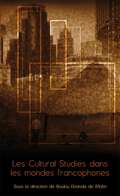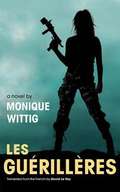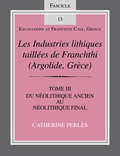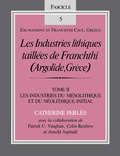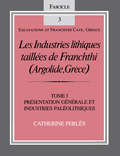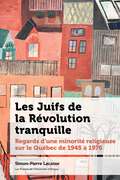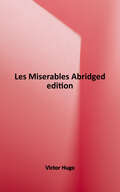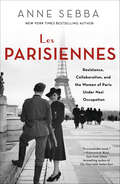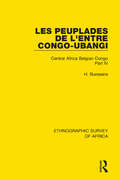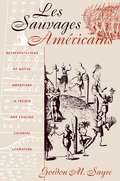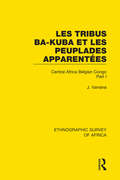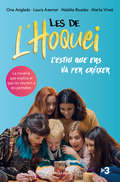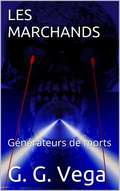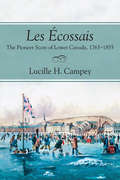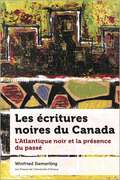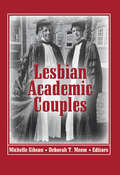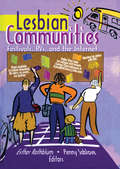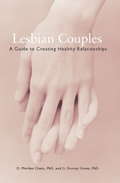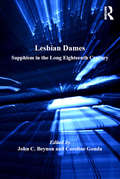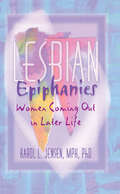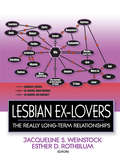- Table View
- List View
Les Cultural Studies dans les mondes francophones (Études culturelles, africaines et diasporiques)
by de B'béri, Boulou EbandaDepuis trois décennies le monde anglo-saxon a considéré sérieusement les Cultural Studies comme une analyse des pratiques quotidiennes et de la production de sens. Mais la production analytique en français dans cette discipline est restée presque absente. Les mondes francophones ont déjà vécu plusieurs événements qui auraient intéressé les Cultural Studies au XXIe siècle : les manifestations sociales de l’hiver 2006 et de l’automne 2007 en France, les mouvements migratoires d’Africains vers l’Europe et le débat sur « les accommodements raisonnables » au Québec entre autres. Pour tous ces événements, nous avions entendu s’élever plusieurs voix qui offraient des articulations généralistes de différentiation de nous à l’autre et des idiomes comme « ces gens-là », « les enfants issus d’immigration », « nous ne voulons pas accueillir la misère du monde » et bien d’autres. Nous n’avions pas entendu s’élever des perspectives provenant des Cultural Studies dans leur compréhension particulière d’événements politiques, ni en France, ni en Belgique, ni en Suisse, encore moins au Québec. Ces perspectives nous invitent à tenir compte des rapports entre discours et représentations, de placer les contextes politiques des pratiques quotidiennes comme prémisses de nos analyses, d’ouvrir les identités aux pratiques de production de sens et de revoir les groupes et formations identitaires. Cet ouvrage a pour but de souligner les repères utiles des Cultural Studies pour mieux comprendre les milieux politiques et culturels de la francophonie au XXIe siècle. Publié en français
Les Guerilleres
by David Le Vay Monique WittigOne of the most widely read feminist texts of the twentieth century, and Monique Wittig's most popular novel, Les Guérillères imagines the attack on the language and bodies of men by a tribe of warrior women. Among the women's most powerful weapons in their assault is laughter, but they also threaten literary and linguistic customs of the patriarchal order with bullets. In this breathtakingly rapid novel first published in 1969, Wittig animates a lesbian society that invites all women to join their fight, their circle, and their community. A path-breaking novel about creating and sustaining freedom, the book derives much of its energy from its vaunting of the female body as a resource for literary invention.
Les Industries lithiques taillées de Franchthi: Du Néolithique ancien au Néolithique final, Fascicle 13 [From the Earliest Neolithic to the End of the Neolithic] (Excavations at Franchthi Cave, Greece)
by Catherine PerlèsWith the long-awaited publication of these three volumes we have the first thorough documentation of one of the most important prehistoric sites in the Mediterranean, that of Franchthi Cave in the Argolid Peninsula of Greece." —American Anthropologist ... an exceptional contribution to the hitherto very inadequate knowledge of this period in Greece." —Antiquity ... the archaeological and paleoenvironmental data from Franchthi Cave are unique in providing a site-specific record of the cultural responses to great environmental changes." —Quarterly Research Perlès's study is impressive in the systematic application of a well-thought-out methodology." —`w` This study of the thousands of chipped/flaked stone tools found in the excavations at Franchthi Cave is the first of its kind in Greek archaeology, if not in the whole of southeastern European prehistory.This is the third of three comprehensive reports on the flaked stone industries from the site, focusing on the Neolithic. Catherine Perlès is Emeritus Professor at the University of Nanterre and holds an honorary degree from Indiana University. She is author of several books, including The Early Neolithic in Greece and Ornaments and Other Ambiguous Artifacts from Franchthi: Volume 1, The Palaeolithic and the Mesolithic (IUP, 2018)
Les Industries lithiques taillées de Franchthi: Les Industries du Mésolithique et du Néolithique Initial, Fascicle 5 [The Mesolithic and Early Neolithic Industries] (Excavations at Franchthi Cave, Greece)
by Colin Renfrew Catherine Perlès Vaughan Patrick C Arnold AspinallWith the long-awaited publication of these three volumes we have the first thorough documentation of one of the most important prehistoric sites in the Mediterranean, that of Franchthi Cave in the Argolid Peninsula of Greece." —American Anthropologist ... an exceptional contribution to the hitherto very inadequate knowledge of this period in Greece." —Antiquity ... the archaeological and paleoenvironmental data from Franchthi Cave are unique in providing a site-specific record of the cultural responses to great environmental changes." —Quarterly Research Perlès's study is impressive in the systematic application of a well-thought-out methodology." —`w` This study of the thousands of chipped/flaked stone tools found in the excavations at Franchthi Cave is the first of its kind in Greek archaeology, if not in the whole of southeastern European prehistory.This is the second of three comprehensive reports on the flaked stone industries from the site, focusing on the Mesolithic. Catherine Perlès is Emeritus Professor at the University of Nanterre and holds an honorary degree from Indiana University. She is author of several books, including The Early Neolithic in Greece and Ornaments and Other Ambiguous Artifacts from Franchthi: Volume 1, The Palaeolithic and the Mesolithic (IUP, 2018)
Les Industries lithiques taillées de Franchthi: Présentation générale et industries Paléolithiques, Fascicle 3 [General Presentation and Paleolithic Industries] (Excavations at Franchthi Cave, Greece)
by Catherine PerlèsWith the long-awaited publication of these three volumes we have the first thorough documentation of one of the most important prehistoric sites in the Mediterranean, that of Franchthi Cave in the Argolid Peninsula of Greece." —American Anthropologist... an exceptional contribution to the hitherto very inadequate knowledge of this period in Greece." —Antiquity... the archaeological and paleoenvironmental data from Franchthi Cave are unique in providing a site-specific record of the cultural responses to great environmental changes." —Quarterly ResearchPerlès's study is impressive in the systematic application of a well-thought-out methodology." —American AntiquityThis study of chipped/flaked stone tools found in the excavations at Franchthi Cave is the first of its kind in Greek archaeology, if not in the whole of southeastern European prehistory.
Les Juifs de la Révolution tranquille: Regards d’une minorité religieuse sur le Québec de 1945 à 1976 (Études canadiennes)
by Simon-Pierre LacasseLa communauté juive québécoise occupe une position politique et culturelle unique en Amérique du Nord et au Canada. Pour cette raison, une identité juive montréalaise distincte de l’identité juive canadienne et états-unienne s'est développée. Peu étudiée dans l’histoire contemporaine québécoise, la période d’après-guerre, jusqu’au milieu des années 1970, voit des changements décisifs s’opérer au sein de la communauté juive québécoise. Dès le lendemain de la guerre, les débats sociopolitiques québécois et les contacts croissants avec les Québécois d’origine canadienne-française influencent le positionnement idéologique de la communauté juive montréalaise. Dans une société largement clivée sur le plan confessionnel entre catholiques et protestants – les « deux solitudes » –, les activistes juifs luttent pour la reconnaissance de leur communauté et incitent les acteurs politiques à réfléchir plus largement à ce que l’on appelle aujourd’hui le « vivre-ensemble ». Loin de demeurer en marge des espaces public et politique, plusieurs activistes communautaires du Montréal juif prennent la parole et défendent une société québécoise émergente au sein de laquelle le pluralisme occupe un espace grandissant.Préface de Pierre Anctil.Mention Spéciale, Canadian Jewish Literary Awards (2023)
Les Miserables (Fawcett Premier)
by Victor HugoFew novels ever swept across the world with such overpowering impact as Les Misérables. Within 24 hours, the first Paris edition was sold out. In other great cities of the world it was devoured with equal relish. Sensational, dramatic, packed with rich excitement and filled with the sweep and violence of human passions, Les Misérables is not only superb adventure but a powerful social document. The story of how the convict Jean-Valjean struggled to escape his past and reaffirm his humanity, in a world brutalized by poverty and ignorance, became the gospel of the poor and the oppressed.
Les Parisiennes: Resistance, Collaboration, and the Women of Paris Under Nazi Occupation
by Anne SebbaThe New York Times–bestselling author explores WWII Paris history and tells the stories of how women survived—or didn’t—during the Nazi occupation.Paris in the 1940s was a place of fear, power, aggression, courage, deprivation, and secrets. During the occupation, the swastika flew from the Eiffel Tower and danger lurked on every corner. While Parisian men were either fighting at the front or captured and forced to work in German factories, the women of Paris were left behind where they would come face to face with the German conquerors on a daily basis, as waitresses, shop assistants, or wives and mothers, increasingly desperate to find food to feed their families as hunger became part of everyday life.When the Nazis and the puppet Vichy regime began rounding up Jews to ship east to concentration camps, the full horror of the war was brought home and the choice between collaboration and resistance became unavoidable. Sebba focuses on the role of women, many of whom faced life and death decisions every day. After the war ended, there would be a fierce settling of accounts between those who made peace with or, worse, helped the occupiers and those who fought the Nazis in any way they could.“Anne Sebba has the nearly miraculous gift of combining the vivid intimacy of the lives of women during The Occupation with the history of the time. This is a remarkable book.” —Edmund de Waal, New York Times–bestselling author“Wonderfully researched . . . puts women’s stories, and the complications of their lives under Occupation, centre stage.” —Kate Mosse, New York Times–bestselling author
Les Peuplades de L'Entre Congo-Ubangi (Ngbandi, Ngbaka, Mbandja, Ngombe et Gens D'Eau): Central Africa Belgian Congo Part IV
by H BurssensRoutledge is proud to be re-issuing this landmark series in association with the International African Institute. The series, published between 1950 and 1977, brings together a wealth of previously un-co-ordinated material on the ethnic groupings and social conditions of African peoples. Concise, critical and (for its time) accurate, the Ethnographic Survey contains sections as follows: Physical Environment Linguistic Data Demography History & Traditions of Origin Nomenclature Grouping Cultural Features: Religion, Witchcraft, Birth, Initiation, Burial Social & Political Organization: Kinship, Marriage, Inheritance, Slavery, Land Tenure, Warfare & Justice Economy & Trade Domestic Architecture Each of the 50 volumes will be available to buy individually, and these are organized into regional sub-groups: East Central Africa, North-Eastern Africa, Southern Africa, West Central Africa, Western Africa, and Central Africa Belgian Congo. The volumes are supplemented with maps, available to view on routledge.com or available as a pdf from the publishers.
Les Sauvages Américains
by Gordon M. SayreAlgonquian and Iroquois natives of the American Northeast were described in great detail by colonial explorers who ventured into the region in the seventeenth and eighteenth centuries. Beginning with the writings of John Smith and Samuel de Champlain, Gordon Sayre analyzes French and English accounts of Native Americans to reveal the rhetorical codes by which their cultures were represented and the influence that these images of Indians had on colonial and modern American society. By emphasizing the work of Pierre Franaois-Xavier Charlevoix, Joseph-Franaois Lafitau, and Baron de Lahontan, among others, Sayre highlights the important contribution that French explorers and ethnographers made to colonial literature. Sayre's interdisciplinary approach draws on anthropology, cultural studies, and literary methodologies. He cautions against dismissing these colonial texts as purveyors of ethnocentric stereotypes, asserting that they offer insights into Native American cultures. Furthermore, early accounts of American Indians reveal Europeans' serious examination of their own customs and values: Sayre demonstrates how encounters with natives' wampum belts, tattoos, and pelt garments, for example, forced colonists to question the nature of money, writing, and clothing; and how the Indians' techniques of warfare and practice of adopting prisoners led to new concepts of cultural identity and inspired key themes in the European enlightenment and American individualism.
Les Tribus Ba-Kuba et les Peuplades Apparentées: Central Africa Belgian Congo Part I
by Jan VansinaRoutledge is proud to be re-issuing this landmark series in association with the International African Institute. The series, published between 1950 and 1977, brings together a wealth of previously un-co-ordinated material on the ethnic groupings and social conditions of African peoples. Concise, critical and (for its time) accurate, the Ethnographic Survey contains sections as follows: Physical Environment Linguistic Data Demography History & Traditions of Origin Nomenclature Grouping Cultural Features: Religion, Witchcraft, Birth, Initiation, Burial Social & Political Organization: Kinship, Marriage, Inheritance, Slavery, Land Tenure, Warfare & Justice Economy & Trade Domestic Architecture Each of the 50 volumes will be available to buy individually, and these are organized into regional sub-groups: East Central Africa, North-Eastern Africa, Southern Africa, West Central Africa, Western Africa, and Central Africa Belgian Congo. The volumes are supplemented with maps, available to view on routledge.com or available as a pdf from the publishers.
Les de l'hoquei: L'estiu que ens va fer créixer
by Ana Anglada Laura Azemar Natalia BoadasLa novel·la de la sèrie d'èxit de TV3 que ens explica el que no veurem a les pantalles: l'estiu entre la primera i la segona temporada. Després d'una temporada dura, les jugadores del Club Patí Minerva han aconseguit salvar el seu equip d'hoquei i han demostrat que juntes són imparables. Però què passa quan acaben els entrenaments i comença el tan esperat estiu? Durant les vacances, l'Emma, la Laila, la Berta, la Raquel, la Lorena, la Flor i la Gina s'embarcaran en aventures de tota mena. Entre els concerts de festa major, els caps de setmana a la platja, les feines temporals i els viatges a l'altra punta del món, les de l'hoquei faran amistats sorprenents, exploraran la seva sexualitat, s'enfrontaran als reptes de fer-se grans i descobriran qui són quan no estan amb la resta de l'equip. Quan es retroben abans del correfoc que ha de posar punt i final a l'estiu, les Minerves s'adonen que créixer és un embolic i que, elque havia de ser el millor estiu de les seves vides, ha acabat posant a prova la seva amistat.
Les marchands
by Guido Galeano Vega Julien SaunierL’éducation appropriée de valeurs sociales humaines est la priorité dans le monde. N’importe qui ayant administré et mené l’économie mondiale, consciemment ou non, de manière intentionnelle ou non, est focalisé sur l’industrie de la mort sur la planète. Cela peut se percevoir par tous les évènements violents que notre génération, supposée évoluée, a souffert. En un siècle, des millions et des millions de ressources ont été gaspillées, et millions et des millions de personnes ont été tuées, en pleine force de l’âge. Apparemment, une partie de l’humanité a perdu l’amour de la vie, et se rue dans les bras de la mort, comme serviteur volontaire pour tuer. Ceux qui tuent sont ceux qui privent la société de recevoir les fruits positifs de la productivité globale. Ce sont ceux qui accumulent les fruits de l’effort et du sacrifice des autres. Ceux qui tuent sont ceux qui investissent les ressources de la planète dans l’industrie de la mort.
Les think tanks et le discours expert sur les politiques publiques au Canada: (1890-2015) (Politique et politiques publiques)
by Julien LandryLes think tanks et le discours expert sur les politiques publiques au Canada : (1890-2015) retrace l’histoire des groupes de réflexion ou think tanks canadiens, tout en inscrivant ceux-ci dans un contexte plus large permettant de mieux comprendre les rapports entre le politique, les sciences sociales et l’analyse des politiques publiques en Amérique du Nord. Julien Landry propose une nouvelle synthèse de la littérature sur les think tanks, les sciences sociales et l’action publique. Il se penche plus particulièrement sur l’organisation et l’ascension des sciences sociales, la consolidation de leurs fonctions technocratiques et la généralisation du recours à leur langage pour analyser les politiques publiques et intervenir dans les débats sociaux. Il fait transparaître les efforts des think tanks pour influencer les débats publics et la consolidation des identités politiques alors que les acteurs sociaux mobilisent des perspectives et des ressources organisationnelles pour imposer leur vision des problèmes sociaux et du rôle de l’État. La fine analyse sociohistorique que fait Julien Landy, qui fait appel au cas américain, montre l’émergence et l’évolution des think tanks en fonction de l’ascension, de la consolidation et de la généralisation des discours d’expertise dans les débats publics et dans l’élaboration des politiques. Ce livre comble une importante lacune dans l’histoire des think tanks canadiens en intégrant celle-ci au cheminement sociopolitique du XXe siècle.
Les Écossais: The Pioneer Scots of Lower Canada, 1763-1855
by Lucille H. CampeyThis is the first fully documented account, produced in modern times, of the migration of Scots to Lower Canada. Scots were in the forefront of the early influx of British settlers, which began in the late eighteenth century. John Nairne and Malcolm Fraser were two of the first Highlanders to make their mark on the province, arriving at La Malbaie soon after the Treaty of Paris in 1763. By the early 1800s many Scottish settlements had been formed along the north side of the Ottawa River, in the Chateauguay Valley to the southwest of Montreal, and in the Gaspe region. Then, as economic conditions in the Highlands and Islands deteriorated by the late 1820s, large numbers of Hebridean crofters settled in the Eastern Townships. The first group came from Arran and the later arrivals from Lewis. Les Ecossais were proud of their Scottish traditions and customs, those living reminders of the old country which had been left behind. In the end they became assimilated into Quebec’s French-speaking society, but along the way they had a huge impact on the province’s early development. How were les Ecossais regarded by their French neighbours? Were they successful pioneers? In her book, Lucille H. Campey assesses their impact as she unravels their story. Drawing from a wide range of fascinating sources, she considers the process of settlement and the harsh realities of life in the New World. She explains how Quebec province came to acquire its distinctive Scottish communities and offers new insights on their experiences and achievements.
Les écritures noires du Canada: L'Atlantique noir et la présence du passé (Études canadiennes)
by Winfried SiemerlingThe Black Atlantic Reconsidered is the first comprehensive work to explore Black Canadian literature from its beginnings to the present in the broader context of the Black Atlantic world. Winfried Siemerling traces the evolution of black Canadian witnessing and writing from slave testimony in New France and the 1783 "Book of Negroes" through the work of contemporary black Canadian writers including Austin Clarke, George Elliott Clarke, Dionne Brand, Wayde Compton, and Esi Edugyan.Arguing that Black writing in Canada is deeply imbricated in a historic transnational network, Winfried Siemerling explores the powerful presence of Black Canadian history, slavery, the Underground Railroad, and the Black diaspora in the work of contemporary Black Canadian writers.Individual chapters examine the literature that has emerged from Quebec, Nova Scotia, the Prairies, and British Columbia, with attention to writing in both English and French.
Lesbian Academic Couples
by Michelle GibsonLearn how lesbian couples deal with political, social, and legal issues related to their relationships-and their professions Lesbian Academic Couples is a collection of writings by scholars who examine-in theory and in narrative-issues faced by partners working in the academic field, including the politics of spousal hiring, discrimination in hiring practices, collaboration between partners, long-distance relationships, team teaching, and job sharing. This unique book presents firsthand accounts from senior faculty with lengthy credentials in LGBT scholarship who have been able to land academic positions not compromised by outing, from established academics who have been outed to negative effect, from junior scholars with a queer specialty, and from faculty whose work is constantly shifting and unpredictable. The format of Lesbian Academic Couples is unique. Authors well known to the lesbian communities in the United States, Canada, and Australia, present essays that "converse" with one another, offering opposing positions that represent a diversity of approaches on vital issues. The book offers candid accounts of the experiences of lesbian couples fortunate enough to work in supportive academic environments and from those discouraged from being out on campus or from doing academic work in the area of LGBT studies. This groundbreaking book is especially timely given current lawsuits and legislation involving civil unions and domestic partner benefits, enforcement of domestic violence statutes, and the rights of unmarried older couples.Lesbian Academic Couples includes the stories of couples who: achieved scholarly success and a reaffirmed relationship were separated when they couldn&’t find viable academic positions in the same geographical area abandoned the security of tenured positions for the sake of their relationship were professionally marginalized because of their same-sex, mixed-race relationship wrote under the pen name "Michael Field" in the nineteenth centuryIn addition, Lesbian Academic Couples examines the critical issues of: state sanctioning through marriage spousal hiring package plans sexual orientation nondiscrimination policiesLesbian Academic Couples have existed, as long as there have been female academics. This powerful book gives voice to their successes and struggles.
Lesbian Activism in the (Post-)Yugoslav Space: Sisterhood and Unity
by Bojan Bilić Marija RadomanThis book intertwines academic and activist voices to engage with more than three decades of lesbian activism in the Yugoslav space. The empirically rich contributions uncover a range of lesbian initiatives and the fundamental, but rarely acknowledged, role that lesbian alliances have played in articulating a feminist response to the upsurge of nationalism, widespread violence against women, and high levels of lesbophobia and homophobia in all of the post-Yugoslav states. By offering a distinctly intergenerational and transnational perspective, this collection does not only shed new light on a severely marginalised group of people, but constitutes a pioneering effort in accounting for the intricacies – solidarities, joys, and tensions – of lesbian activist organising in a post-conflict and post-socialist environment. With a plethora of authorial standpoints and innovative methodological approaches, the volume challenges the systematic absence of (post-)Yugoslav lesbian activist enterprises from recent social science scholarship.Lesbian Activism in the (Post-)Yugoslav Space will be of interest to students and scholars across a range of disciplines, including gender studies, history, politics, anthropology, and sociology.
Lesbian Communities: Festivals, RVs, and the Internet
by Esther D Rothblum Penny Sablove"I had just witnessed women who shingled their own roofs, drove eighteen-wheeler trucks, and built their own houses-as well as kept them clean and cooked a damn good meal. On women&’s land I am a first-class citizen, I&’m treated as an equal. I now see the world with righteous anger and hope. Living in womyn&’s community has provided that lens for me."-Elizabeth Sturrus, third wave feministOne of the driving forces in the lives of many lesbians is the search for community in a society that favors heterosexuality and often turns a cold shoulder toward women who love women. Lesbian Communities: Festivals, RVs, and the Internet takes you inside flourishing lesbian communities-physical, spiritual, and virtual (online)-that provide practical help, emotional support, and much-needed outlets for creative expression. Exploring communities functioning in harmony with general American society as well as separatist groups, "festival communities" which form for short times annually, and informal online groups offering meaningful communication to physically isolated lesbians, this book offers a ray of light to those whose search is still ongoing. It also provides much-needed analysis of the current state of lesbian communities-some decades old now-for educators, researchers, and social scientists. In Lesbian Communities: Festivals, RVs, and the Internet, Susan Krieger revisits the vibrant community she first explored in The Mirror Dance. An African American member of Old Lesbians Organizing for Change shares the details of her search for a cooperative, caring space for aging lesbians-and what led to her eventual decision to create this space herself. And one of the founders of Hallomas, a back-to-the-land community that has survived in northern California since the late 1970s, reflects on that unique community&’s birth and life-with 13 photographs and illustrations. The book also bears witness to a life-changing encounter and dialogue between second-wave feminists from the woman's land collective of Arcadia and third wave feminists. You&’ll also learn about: the birth, joys, and tribulations of an online community that becomes physical each year at the Michigan Womyn&’s Music Festival the accidental birth of a lesbian community in isolated and fundamentalist-dominated West Texas the international online lesbian parenting community called MOMS (affectionately known as Dykes and Tykes)-how it began, what belonging to this community provides for its members, and a look toward the future the debate on inclusiveness versus exclusiveness (of bisexual women, transgender people, and the male children of lesbians) in lesbian communities the current decline of availability and dilution of the purity of lesbian-only space-and the rise of segregation (by social class and financial status) and oppression within the lesbian community the current plight of lesbian bookstores, which since the 1970s have served not only as gateways to a multitude of lesbian communities, but as the centers of lesbian communities themselves the online experience of lesbians searching for community in Japan the issues facing Jewish lesbians and the formation of Nice Jewish Girls, a Montreal group for anyone who identifies as a lesbian, bisexual, or queer woman and their non-Jewish partners and friends the power of myth and mythmaking to help women regain lost strength and reclaim lost history From the efforts of back-to-the-land groups creating "wimmin&’s space" to life in modern residential/retirement settings, this book explores the places created by and for lesbians. Photos and illustrations bring these women and their communities to life. Lesbian Communities: Festivals, RVs, and the Internet w
Lesbian Couples
by D. Merilee Clunis G. Dorsey GreenWritten by two well-known lesbian psychologists, this book is a guide to developing and maintaining lesbian relationships. No matter how short or long your current relationship has been, a review of this book is always helpful.
Lesbian Couples: A Guide to Creating Healthy Relationships
by Ph.D. D.Merilee Clunis Ph.D. G. Dorsey GreenWritten by two experienced lesbian therapists, Lesbian Couples covers a range of topics-commitment ceremonies and marriage, living arrangements, work, money, togetherness and separate identities, coming out to family and friends, resolving conflict and understanding each other-and uses a variety of helpful examples and problem-solving techniques, drawing from research done on lesbian couples over the past decade. The book pays special attention to differences of race, class, age and physical ability, and addresses the issues raised when one or both partners are recovering from alcohol, substance, or sexual abuse. The book also addresses differences that lesbians may encounter in their relationships regarding such issues as butch-femme, transgender identity, bisexuality, monogamy, and s/m. Thoroughly readable and extremely helpful, with an updated resource guide, Lesbian Couples is a book that every lesbian will want to own.
Lesbian Dames: Sapphism in the Long Eighteenth Century (Queer Interventions Ser.)
by Caroline GondaHow are romantic and erotic relationships between women represented in the literature of the long eighteenth century? How does Sapphism surface in other contemporary discourses, including politics, pornography, economics and art? After more than a generation of lesbian-gay scholarship that has examined identities, practices, prohibitions and transgressions surrounding same-sex desire, this collection offers an exciting and indispensable array of new scholarship in gender and sexuality studies. The contributors - who include noted writers, critics and historians such as Emma Donoghue, George E. Haggerty, Susan S. Lanser and Valerie Traub - provide varied and provocative research into the dynamics and histories of lesbianism and Sapphism. They build on the work of scholarship on Sapphism and interrogate the efficacy of such a notion in describing the varieties of same-sex love between women during the long eighteenth century. This groundbreaking collection, the first multi-authored volume to examine lesbian representation and culture in this era, presents a diversity of theoretical and critical approaches, from close literary analysis to the history of reading and publishing, psychoanalysis, biography, historicism, deconstruction and queer theory.
Lesbian Death: Desire and Danger between Feminist and Queer
by Mairead SullivanEngaging with fears of lesbian death to explore the value of lesbian beyond identity The loss of lesbian spaces, as well as ideas of the lesbian as anachronistic has called into question the place of lesbian identity within our current culture. In Lesbian Death, Mairead Sullivan probes the perception that lesbian status is in retreat, exploring the political promises—and especially the failures—of lesbian feminism and its usefulness today. Lesbian Death reads how lesbian is conceptualized in relation to death from the 1970s onward to argue that lesbian offers disruptive potential. Lesbian Death examines the rise of lesbian breast cancer activism in San Francisco in conversation with ACT UP, the lesbian separatist manifestos &“The C.L.I.T. Papers,&” the enduring specter of lesbian bed death, and the weaponization of lesbian identity against trans lives. By situating the lesbian as a border figure between feminist and queer, Lesbian Death offers a fresh perspective on the value of lesbian for both feminist and queer projects, even if her value is her death.
Lesbian Epiphanies: Women Coming Out in Later Life
by Karol L JensenExploring identity development and gender orientation, Lesbian Epiphanies: Women Coming Out in Later Life contains firsthand information about the experiences and difficulties of women who discover and reveal their newfound lesbian sexuality in later life. Psychologists, social workers, counselors, and professors will find that Lesbian Epiphanies is the first book to extensively quote from interviews of lesbians and bisexuals who had entered into heterosexual marriages. From the analysis of these 24 interviews, the psychological, erotic, and social processes of women who come out as lesbians or bisexuals after a heterosexual marriage are clearly explained so you can better assist your clients throughout this coming-out process. Discussing the personal and societal standards which clouded early self-awareness for these women, Lesbian Epiphanies lifts the veil of confusion to clearly illuminate the issues at hand to assist you in understanding and helping your clients. From the case studies in this important book, you will learn how some women came to realize their same gender attractions and the barriers they faced, including negative attitudes toward lesbian women and the lack of strong role models. Helpful and informative, Lesbian Epiphanies explores the development of sexual identity in women in the Unites States today and provides you with essential information to help you improve your services to lesbian and bisexual clients by: examining how the role of marriage in American culture stifles a woman’s self-awareness of her sexuality in order to help clients avoid the mistake of a heterosexual marriage before husbands and children are involved examining reasons behind the lack of valuable sexual information in America that limits a woman’s general awareness of herself, her body, her sexuality, and her life options understanding the challenges that lesbians and bisexuals experience when attempting to establish their true identities to assist your clients in overcoming these barriers suggesting support groups for clients who are having a difficult time becoming used to the ideas and feelings of some same gender attractionsThis insightful book knocks down the sociological and psychological barriers that keep women from realizing or acknowledging their real sexual orientation by dispelling societal and cultural myths about what it means to be a woman in the United States. Offering you invaluable advice on how to help clients effectively and happily live with their new identities, Lesbian Epiphanies provides solutions to the challenges that women experience in establishing their other-than-heterosexual orientation in a heterosexist society.
Lesbian Ex-Lovers: The Really Long-Term Relationships
by Esther D Rothblum Jacqueline Weinstock"We have earned a certain place in each other&’s lives, and in the best of times we can rest on what we have made together." Lesbian Ex-Lovers: The Really Long-Term Relationships examines the need for the development of better understanding and more critical analysis of lesbian ex-lover relationships. This eye-opening look into the minds and hearts of women offers personal insight into the possibilities for and potential pitfalls of lesbian ex-lover relations. This book contains personal stories, fictional accounts, poetry, and theoretical analyses of the frequency and significance of ex-lovers at different stages in a relationship. Topics of interest in Lesbian Ex-Lovers include: the roles ex-lovers play in our lives ex-lovers as contexts for change and development how we continue to be influenced by ex-lovers letting go and moving on ex-lovers as current friends and family themes of betrayal and loss of faith reconstructing friendships and community the mystique of the ex-lover friend/family connections among lesbian ex-lovers "Rather than totally scrap a relationship, we recycle it-from lover to ex-lover to friend in a relatively short half-life." Lesbian Ex-Lovers is the only book in print that explores how a lesbian&’s ex-lovers impact her subsequent romances and lifestyle. This special collection adds a new dynamic to the current literature for and about the lesbian community. Lesbian Ex-Lovers offers advice, anecdotes, and interpretations from such authors, poetesses, and artists as: Michelle Gibson, PhD-educator and editor of Femme/Butch: New Considerations of the Way We Want to Go- who says goodbye to her lover in a sad, passionate elegy Marny Hall-Psychotherapist, editor of the anthology Sexualities, and author of several books, including The Lavender Couch: A Consumer&’s Guide to Psychotherapy for Lesbians and Gay Men-who muses on the unique bonding between lesbians and their ex-lovers, lending a mystique that surrounds the lesbian lifestyle Alison Bechdel-creator of the comic strip Dykes to Watch Out For-who presents a humorous comic strip thanking her former lovers for teaching her about herself Jane Futcher-newspaper reporter and author of three novels-who uses a chapter in her novel to illustrate the tensions that can occur when ex-lovers choose to remain friends, especially when those bonds provoke jealousy in both current and ex-lovers Renny Christopher-educator and award-winning poetess-who expresses her love, loss, and regret in three poems about her ex-lover and much more!
